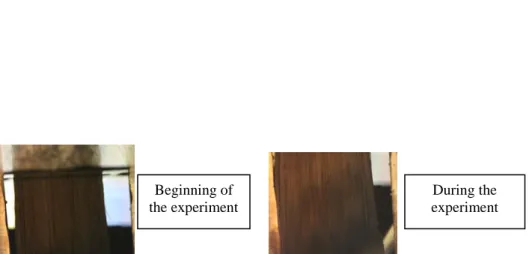HAL Id: hal-02116849
https://hal-amu.archives-ouvertes.fr/hal-02116849
Submitted on 1 May 2019
HAL is a multi-disciplinary open access
archive for the deposit and dissemination of
sci-entific research documents, whether they are
pub-lished or not. The documents may come from
teaching and research institutions in France or
abroad, or from public or private research centers.
L’archive ouverte pluridisciplinaire HAL, est
destinée au dépôt et à la diffusion de documents
scientifiques de niveau recherche, publiés ou non,
émanant des établissements d’enseignement et de
recherche français ou étrangers, des laboratoires
publics ou privés.
Recovery of carbon fibres from composite waste by
hydrolysis in subcritical water
Chaima Chaabani, Elsa Weiss-Hortala, Jean-Henry Ferrasse, Olivier Boutin,
Yannick Soudais
To cite this version:
Chaima Chaabani, Elsa Weiss-Hortala, Jean-Henry Ferrasse, Olivier Boutin, Yannick Soudais.
Re-covery of carbon fibres from composite waste by hydrolysis in subcritical water. NAXSOS 2018, Jun
2018, Naxos Island, Greece. �hal-02116849�
Recovery of carbon fibres from composite waste by hydrolysis in subcritical water
C. Chaabani 1, E. Weiss-Hortalaa1, J.H. Ferrasse2, O. Boutin2, Y. Soudais1 1 Université de Toulouse, Ecole des Mines d'Albi, CNRS, RAPSODEE, ALBI, France
2 Aix Marseille Univ, CNRS, Centrale Marseille, M2P2, Marseille, France
Keywords: carbon fibers, thermoplastic resin, subcritical water, recycling. Presenting author email: olivier.boutin@univ-amu.fr
Carbon fibers reinforced Polymers (CFRP) has boosted several fields such as aeronautic and aerospace industry. Nowadays, they are also increasingly used in automotive, leisure and sports sectors. The residues of these materials are being discarded every year, which creates serious ecological and social problems. Many efforts have been launched in their further utilization after use. Several recycling technologies are assessed: pyrolysis (Jiang et al 2016), steam thermolysis (Ye et al 2013) and solvolysis (Oliveux et al 2015). Chemical recycling using sub and supercritical fluids shows good prospects for recycling carbon fibers. Hydrothermal conversion of waste composite reinforced with carbon fibers was investigated using subcritical water as reactive-media. This process is applied to decompose the PA6 resin as the matrix of the composite to recover carbon fibers.
A 150 mL reactor equipped with a view cell was used (Top Industries, France, Figure 1). The temperature is controlled and varied between 150 and 280°C under 25 MPa from 5 to 60min of reaction times. The process was visualized through a sapphire window. A CCD camera was used to detect the defibrillation of the composite during the experiment. The amount of carbon recovered in liquid phase was measured by Total Organic Carbon (TOC). The recovered carbon fibers were observed using scanning electron microscopy (SEM).
Figure 1. Experimental apparatus.
The process efficiency was evaluated by three parameters: the resin removal, the amount of carbon in the liquid phase and the quality (surface) of carbon fibers. The resin removal reached the maximum yield at 280°C, 25 MPa within 15min using different massic ratio composite/water (0.0077- 0.0121 and 0.2732 g.mL-1) (Table 1). Thus, these operating conditions were very efficient to achieve resin removal. Figure 2 shows the defibrillation of the composite during the experiment. The carbon balance combining the amount of carbon in the liquid phase and in the residual resin on carbon fibers surface is evaluated close to 100 wt.%. ESEM analysis revealed clean carbon fibers without physical damage. The morphology of recovered carbon fibers was similar to the virgin ones. Further characterizations are in progress, particularly the tensile strength test.
Table 1. Comparison between theoretical predictions and experimental measurements (operating conditions: T = 280°C, P = 25MPa, t = 15min) Ratio (weight of composite/water volume) (g/ml) Resin removal (wt%) 0.0077 101.8 0.0121 107.0
Figure 2. Photos of the composite during the reaction at 280°C, 25 MPa.
Next works will be to increase the ratio (weight of composite/ water volume) to evaluate the limits on water reactivity, saturation and diffusion phenomenon and to development of industrial reactor to recover long carbon fibers.
References
Jiang G., Pickering S.J. Stucture-property relationship of recycled carbon fibers revealed by pyrolysis recycling process. Journal of Materials Science 2016, 51:1949-1958.
Ye S.Y., Bounaceur, A., Soudais Y., Barna R. Parameter Optimization of the steam thermolysis: A process to recover Carbon fibers from Polymer-Matrix Composites. Waste and Biomass Valorization 2013, 4:73-86. Oliveux G, Dandy Luke O, Leeke Gary A. Current status of recycling of fibre reinforced polymers: Review of technologies, reuse and resulting properties. Progress in Materials Science 2015, 72:61-99
0.2732 100.0
Beginning of the experiment
During the experiment

